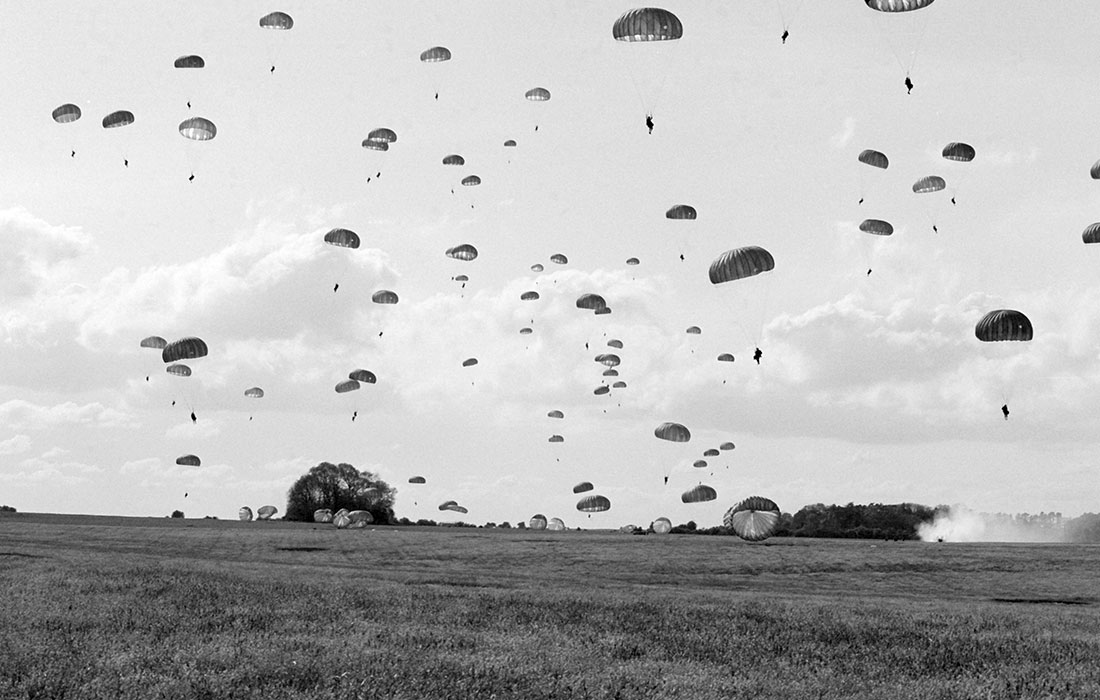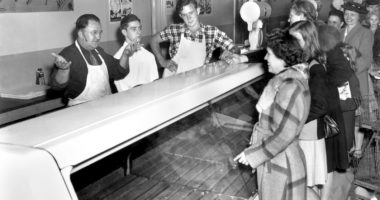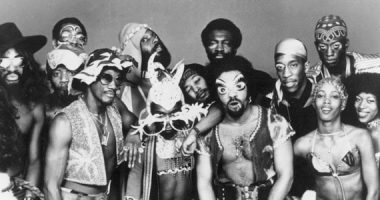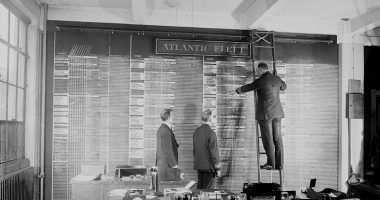
82a Airborne Divisió i paracaigudistes britànics es tiren durant la celebració del 40è aniversari del Dia D, 1984 | The U.S. National Archives | Domini Públic
Images sketch out a whole world and act on the wishes of the people. If space was constructed – colonised, as a future synonym, by Western powers, then distorting its images and icons is a way to disrupt the present, a way to activate tools for resistance, social mobilisation and collective transformation.
Jararaca, the leader of the Black Commando of Rio de Janeiro, stares at the television camera with a tense look. After he reads out the five demands made by the Black Command to the Government, millions of viewers wait for the end of the declaration by the black leader of a revolution the likes of which have never been seen in the Marvellous City. For the first time, there exists a commando of drug traffickers that is fighting to improve life in the favelas, and which has a political plan for the whole of Brazil.
Jararaca wears a t-shirt with a print of a black fist, a machine gun and a yellow star. In solemn conclusion, he says “We are turning a page in the history of Brazil. This country will never be the same again. Good morning, freedom!”.
The scene with Jararaca never happened. The Black Commando was thought up by the Angolan writer José Eduardo Agualusa in his novel O ano em que Zumbi tomou o Rio de Janeiro (The year that Zumbi took Rio de Janeiro). However, the image of the character making political demands takes on a real dimension. What would happen if someone made impactful illustrations of the imaginary Black Commando? And what if social movements stuck up posters on the walls of Rio? And if someone, after a demonstration, used the five points of the Black Command’s manifesto to negotiate with political leaders?
Fiction, according to the philosopher Jacques Rancière, is not the opposite of reality. Fiction is a way of moulding reality, of adding names, images and stories that multiply reality and wipe away its unambiguity. Images taken from fiction unfold reality and redefine it. Rancière considers that both artistic fiction – the mental images that spring from a novel, for example – and political action overlap with reality, bringing forth new subjects that were previously imperceptible. Fiction breeds dissent, it highlights new connections and forges new relationships between appearance and reality.
Indigenous people on the moon
Some native Columbians, from the Emberá ethnic group, light candles in the dark. A visual projection on the wall recreates the surface of the moon and marks out the silhouettes of the bodies of the jaibanás (shamans) while they perform an ancestral ritual for the healing and harmonisation of beings. Everyone shares bowls filled with drink and plays quenas. The scene forms part of a piece performed by the Columbian collective Oficina de Asuntos Extraterrestres (The Office for Extraterrestrial Affairs) in the Centro de Arte Contemporáneo de Quito (CAC) in March 2014. It was the opening day of the exhibition Arte en órbita (Art in Orbit) which questioned the Western view of space and proposed a series of images to decolonise the future. According to Pedro Soler, the exhibition’s curator, “it was a call to take over space with a defiant, irreverent, iconoclastic, post-colonial attitude”. The images of indigenous people on the surface of the moon raising the flag of the Andean community deconstructs the image of that other astronaut (Neil Armstrong) who one day placed another flag (that of the USA) on the moon.
Space has always been a place that has fed the imagination and generated social organisation. Quito, like many other places in Latin America, was an important centre for astronomical observation during the pre-Columbian era. Despite this, the imaginary of outer space was colonised by the superpowers. In the words of Pedro Soler, ancestral space explorations and space-related cultural production outside of the empire “were invisibilised”. Generating space imaginaries brings about social changes. This is why Arte en órbita launched a package of images of other possible spaces and other viable futures. Images of cosmonauts from the artistic project Palestine Space Agency walking through the olive groves of the West Bank and Gaza. Images of the members of the collective Kongo Astronautswalking along the streets of Kinshasa, creating an alternative commonplace reality. The photographs from the series Carne Negra (Black Meat) by the Brazilian Afrofuturist artist Leila Lopes Negalaize bring together the shapes, curved lines and sexual parts of the female body, weaving an erotic relationship between the bodies of black women and the cosmic world.
The images from Arte en órbita question the established order, subvert the present, unfold reality and stir up time. The images seem to voice questions and answers that activate the political desires of subjects considered as inferior by the Western heteropatriarchy (women, native people, people of African descent). How will we reach the future if only white men are launched into space?, the images whisper.
The costumes created by the Russian artist Alexandra Exter for the film Aelita, Queen of Mars in 1924 cross the decades with irreverence, associating femininity with space. Nyota Upenda Uhura, the black female officer in the series Star Trek, inspired a little girl from Alabama, Mae Jemison, to dream about space and, many years later, to become the first astronaut of African descent. The Afrofuturism started by the musician Sun Ra in the 1970s invoked a future in which black people had control over their own destinies. Afrofuturism, present in films and in mythical bands like Parliament, used the imagination to strengthen the self-representation and social change of the black race.
The illustration Screen from All New Gen, launched by the cyberfeminist collective VNS Matrix in 1992, continues to disrupt our present and inspire the fight of women around the world. All these images of the future interfere with the imaginaries created by power. They are images that resignify, deconstruct and reinvent the supposed universal values of white progress that emerged during the European Enlightenment. They are ammunition for fighting in the present.
What is the true power of images?
The epitomisation of a world
At the beginning of the novel The Charterhouse of Parma, Stendhal describes how a caricature drawn on a serviette triggers a popular revolt. When in May 1796 the French army arrives in Parma, a young painter named Gros overhears in a café terrible stories about the Archduke of Parma, who is speculating with corn. Gros, writes Stendhal, picked up “a sheet of coarse yellow paper. On the back of this he drew the fat Archduke; a French soldier was stabbing him with his bayonet in the stomach, and instead of blood there gushed out an incredible quantity of corn. (…) The drawing, left by Gros on the table of the Caffè dei Servi, seemed a miracle fallen from heaven; it was engraved and printed during the night, and next day twenty thousand copies of it were sold”. The image was already in the minds of the people of Parma during the years in which the despotic Archduke governed. The serviette manifested an image that had been secretly shared by the entire population.
Gros’s caricature is described in the introduction to the book The Design of Dissent by the playwright Tony Kushner as a flagrant truth that still needed to be organised: “some truth that lies imprisoned beneath the surface of public discourse is suddenly, finally liberated, a cry of rebellion carrying everywhere at once, a cry all the more powerful for being entirely silent”. Gros’s drawing has a characteristic that is present in all the best protest designs in history – it is an epitome.
Epitomisation was essential in the agitprop of the artists involved in the Russian Revolution and in the political posters of the Cuban Revolution. It is also a characteristic of some of history’s most iconic images, whatever their format. Our Lady of Guadalupe with the black balaclava used by the Mexican neozapatista movement (which was the poster to mark the first anniversary of the Zapatista uprising) and the photograph of a Palestinian child throwing a stone at an Israeli helicopter are images that encapsulate an era. But they are not a simplification, rather a condensation; a defragmentation of diverse wishes and strands of discontent.
However, the images of the Palestinian cosmonauts seem somehow more disruptive than those of the children pitched against helicopters. The symbolic universe suggested by the Palestine Space Agency evokes another future, another possible reality. The images sketch out a whole world and they act on the wishes of the people. If space was constructed – colonised, as a future synonym, by Western powers, then distorting its images and icons is a way to disrupt the present. Constructing images related to space in Palestine, within the suffocating limits of the Israeli conflict, is a way of activating tools for resistance, social mobilisation and collective transformation.
Shortcuts to the future
In 1992, the book The End of History and the Last Man, by Francis Fukuyama, announced the end of all the utopias. After the fall of the Berlin wall and of the communist regimes, Fukuyama foresaw a new era without ideological struggles, governed by the free market and by liberal democracy. The end of history was also the end of a finished and, in a sense, failed European modernity. The end of history erected a wall. Since then, it seems impossible to imagine anything on the other side. It is impossible to glimpse a positive future for humanity. Even technology, which for decades embodied utopian hopes, has become a despotic divinity that dissolves the future and only reproduces fragments inside loops, inside bubbles of affinity that float over a cyberspace full of fake news.
How can we escape from the labyrinth of the end of history? Are there any tools or methods to knock down the wall that sucks the imagination out of humanity? Ernst Bloch, in his famous essay The Principle of Hope, studied how hope persists, even in terrible situations, thanks to “wishful images”. These are images that serve as prototypes for crossing borders; images that are emotionally charged. Images that we can use to land in a future hijacked by the end of history. A “wishful image” creates a distilled fiction, a kind of shortcut for landing in the future.
In the music video ¡Llegamos al futuro! by the Cuban band Nacional Electrónica, two cosmonauts attempt to take off from a roof terrace in Havana. This scene, with the city rooftops and the ocean in the background, questions the established order. It suggests other possible ways of existing in the world. It even brings to life a collective subject that is trying to step outside the political reality of Cuba. And therein lies the mystery of the synthetic-fictional images which, more than shortcuts to the future, are tools for altering the present. They are the common ground of a present-future full of detours. At the end of the day, the future is nothing more than our stark present – a present with an open ending.
Andrea de la Serna fabulates the concept of “people to come” to highlight the potential of the future in the present. The “people to come” are not the people of the future, but rather the people that are emerging, the people that are coming into being, that are in the process of subjectification and transformation, that are creating new ways of living and relating to each other. This is why, as she writes in her article Un común porvenir (A common future), we should no longer place our hopes in a revolution with some future timeframe, but rather create the conditions to build the timeframe we want. To jump over the wall of the end of history, humanity must rebuild its trust in the forces of the present.
When a detour appears, however small it may be, it should be encouraged and allowed to breathe. By bringing people together, nurturing ourselves as a community, creating wishful images all around. Images for landing in the present-future, images inhabited by subversive realities that are coming into being. It is not the future of the revolution that we should be thinking about, but the revolutionary possibilities that already exist in each of us and in the fabric of shared fictions.





Laura Inclån | 06 July 2021
Increíble artículo de Bernardo Gutiérrez. Muy interesante, una nueva perspectiva bien combativa. Bravo.
Usuari | 10 July 2021
Una nota: “¿Cómo vamos a llegar al futuro si solo son lanzados hombres blancos al espacio?” La pregunta no tiene sentido porque la premisa es falsa. Véase:
https://en.wikipedia.org/wiki/Women_in_space
https://en.wikipedia.org/wiki/List_of_female_spacefarers
https://es.wikipedia.org/wiki/Arnaldo_Tamayo_M%C3%A9ndez
https://en.wikipedia.org/wiki/List_of_African-American_astronauts
https://en.wikipedia.org/wiki/List_of_Hispanic_astronauts
https://es.wikipedia.org/wiki/John_Herrington
Leave a comment